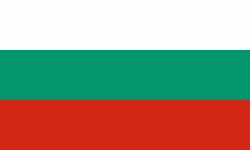Provadia
Provadia (Провадия ) is a town in northeastern Bulgaria, part of Varna Province, located in a deep karst gorge (Provadia syncline) along the Provadiya River not far from the Bulgarian Black Sea Coast. It is the administrative centre of Provadia Municipality. As of December 2009, the town has a population of 12,901 inhabitants.
Provadia served as a customs point since ancient times. It is well known for salty mineral waters, its mild climate and a total of 70 km of caves in the surrounding mountain walls. It can be reached by train from Sofia or Varna and there are also hourly buses from and to Varna, and a sophisticated road system.
Provadia is the site of Solnitsata, Europe's oldest prehistoric town. Excavations on city walls that started in 2005 reveal a town that dates back to between 4,700 BC and 4,200 BC. It is believed to have been the site of salt trading.
Historical names of the medieval fortress, the ruins of which have been preserved until today, include Provat (Byzantine Greek), Ovech (Овеч, Bulgarian), Provanto (Italian) and Pravadı (Turkish language). The Greek name and its adaptations stem from the word πρόβατο, provato, "sheep", and the medieval Bulgarian name corresponds directly (being derived from овца, ovtsa, with the same meaning). The fortress is open for visitors.
During the Middle Ages the town was a key centre of the First Bulgarian Empire with an important monastery at the modern village of Ravna, the church of which was consecrated on 23 April 897, and a major scriptorium of the Preslav Literary School. The rebel leader and subsequently emperor of Bulgaria Ivailo defeated a 10,000-strong Byzantine army near the city in 1279. During the Second Bulgarian Empire it was the seat of a metropolitan in the 14th century. Ovech was captured by the Ottomans in 1388 after a long siege.
In the 17th and 18th century Provadia was a commercial centre of the Ottoman Empire and was inhabited by many Jewish and Ragusan merchants. A 16th-17th-century Dubrovnik-style church still stands in the nearby village of Dobrina.
Provadia served as a customs point since ancient times. It is well known for salty mineral waters, its mild climate and a total of 70 km of caves in the surrounding mountain walls. It can be reached by train from Sofia or Varna and there are also hourly buses from and to Varna, and a sophisticated road system.
Provadia is the site of Solnitsata, Europe's oldest prehistoric town. Excavations on city walls that started in 2005 reveal a town that dates back to between 4,700 BC and 4,200 BC. It is believed to have been the site of salt trading.
Historical names of the medieval fortress, the ruins of which have been preserved until today, include Provat (Byzantine Greek), Ovech (Овеч, Bulgarian), Provanto (Italian) and Pravadı (Turkish language). The Greek name and its adaptations stem from the word πρόβατο, provato, "sheep", and the medieval Bulgarian name corresponds directly (being derived from овца, ovtsa, with the same meaning). The fortress is open for visitors.
During the Middle Ages the town was a key centre of the First Bulgarian Empire with an important monastery at the modern village of Ravna, the church of which was consecrated on 23 April 897, and a major scriptorium of the Preslav Literary School. The rebel leader and subsequently emperor of Bulgaria Ivailo defeated a 10,000-strong Byzantine army near the city in 1279. During the Second Bulgarian Empire it was the seat of a metropolitan in the 14th century. Ovech was captured by the Ottomans in 1388 after a long siege.
In the 17th and 18th century Provadia was a commercial centre of the Ottoman Empire and was inhabited by many Jewish and Ragusan merchants. A 16th-17th-century Dubrovnik-style church still stands in the nearby village of Dobrina.
Map - Provadia
Map
Country - Bulgaria
 |
 |
| Flag of Bulgaria | |
One of the earliest societies in the lands of modern-day Bulgaria was the Neolithic Karanovo culture, which dates back to 6,500 BC. In the 6th to 3rd century BC the region was a battleground for ancient Thracians, Persians, Celts and Macedonians; stability came when the Roman Empire conquered the region in AD 45. After the Roman state splintered, tribal invasions in the region resumed. Around the 6th century, these territories were settled by the early Slavs. The Bulgars, led by Asparuh, attacked from the lands of Old Great Bulgaria and permanently invaded the Balkans in the late 7th century. They established the First Bulgarian Empire, victoriously recognised by treaty in 681 AD by the Eastern Roman Empire. It dominated most of the Balkans and significantly influenced Slavic cultures by developing the Cyrillic script. The First Bulgarian Empire lasted until the early 11th century, when Byzantine emperor Basil II conquered and dismantled it. A successful Bulgarian revolt in 1185 established a Second Bulgarian Empire, which reached its apex under Ivan Asen II (1218–1241). After numerous exhausting wars and feudal strife, the empire disintegrated and in 1396 fell under Ottoman rule for nearly five centuries.
Currency / Language
| ISO | Currency | Symbol | Significant figures |
|---|---|---|---|
| BGN | Bulgarian lev | лв | 2 |
| ISO | Language |
|---|---|
| BG | Bulgarian language |
| TR | Turkish language |















